“2 stycznia 1492 r. Abu-Abdullah, ostatni król dynastii Nasrydów, poddał Alhambrę oblegającym ją Hiszpanom i wraz z królową opuścił zamek, udając się na wygnanie. Po drodze orszak zatrzymał się na pobliskim wzgórzu. Król raz jeszcze spojrzał na pałac i zapłakał. Wiedział, że na zawsze opuszcza ziemski raj i siódme niebo. Od tego czasu wzgórze to nazywane jest Ultimo Suspiro del Moro“(Ostatnie Westchnienie Maura).
<“On January 2, 1492, Abu-Abdullah, the last king of the Nasrid dynasty, surrendered the Alhambra to besieging it The Spaniards and the queen left the castle, going into exile. On the way, the retinue stopped at a nearby hill. The king looked at the palace once more and cried. He knew he was leaving Earth’s paradise and seventh heaven forever. Since then, this hill has been called Ultimo Suspiro del Moro “ > (Last Sigh Maura).
Położony w sercu Andaluzji XIV-wieczny kompleks pałacowo-ogrodowy, oferujący zapierający dech w piersiach widok na Grenadę, to obowiązkowy punkt w programie podróży po Hiszpanii. Jedno z najważniejszych zabytków arabskiego budownictwa w Europie, niegdyś siedziba emiratów Grenady, twierdza mauretańskich kalifów. .Wchodząc tu , przenosisz się w czasie do zupełnie innego świata. Przed twymi oczami pojawią się miejsca jak z «Tysiąca i jednej nocy»
<Located in the heart of Andalusia, the 14th-century palace and garden complex, offering a breathtaking view of Granada, is a must for a travel program in Spain. One of the most important monuments of Arab construction in Europe, once the seat of the emirates of Granada, the fortress of the Moorish caliphs. By entering here, you are moving in time to a completely different world. Before your eyes, there will be places like from «Thousand and One Nights»>
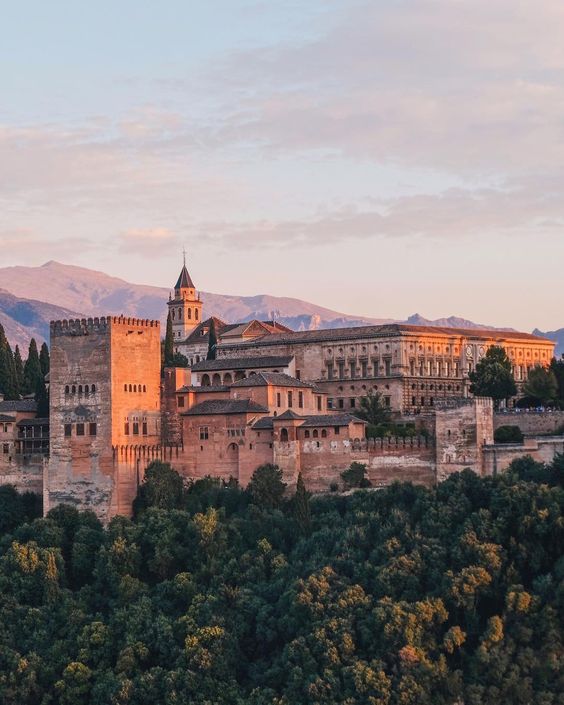
HISTORIA / HISTORY
Naukowcy i historycy nie są zgodni co do dokładnej daty powstania Alhambry. Najstarsze zapisy sięgają IX wieku. Wtedy to obiekt był traktowany wyłącznie jako twierdza wojskowa. Dopiero w XIII wieku dynastia Nasrydów rozpoczęła rozbudowę Alhambry. Rodzina królewska zamieszkała w pięknym pałacu. Dopiero w 1492 roku podczas rekonkwisty ta twierdza mauretańska została zdobyta i przejęta przez Królów Katolickich. Setki lat burzliwej historii odcisnęły piętno na murach Alhambry. Twierdza jednak przetrwała jako świadek dziejów tych ziem. Stawiła czoło trudnym czasom wojny.
Pałac był przebudowywany kilkakrotnie. Po długim okresie stagnacji, w 1870 roku Alhambra została uznana za zabytek narodowy.W 1984 Alhambra została wpisana na Listę Światowego Dziedzictwa UNESCO.
<Researchers and historians disagree about the exact date of the Alhambra. The oldest records date back to the ninth century. At that time, the object was treated only as a military fortress. It was not until the 13th century that the Nasrid dynasty began the expansion of the Alhambra. The royal family lived in a beautiful palace. It was only in 1492 during the reconquest that this Moorish fortress was conquered and taken over by the Catholic Kings. Hundreds of years of turbulent history have left their mark on the walls of the Alhambra. The fortress, however, survived as a witness to the history of these lands. She faced the difficult times of the war. The palace was rebuilt several times. After a long period of stagnation, in 1870 the Alhambra was declared a national monument. In 1984, the Alhambra was inscribed on the UNESCO World Heritage List.>
BUDOWA PAŁACU / CONSTRUCTION OF THE PALACE
Pałac Nasrydów Mauretańskie łuki, zieleń, tysiące kwiatów, witraże, marmurowe podłogi, mityczne posągi, fontanny, dziedzińce okolone cienistymi kolumnadami, wodotryski, rezydencje, ogródki z płynącą wodą, ornamenty przedstawiające wersety Koranu – to wszystko tworzy niepowtarzalny klimat i nastrój. Gdy spacerujemy po starożytnej rezydencji królewskiej czuć atmosferę minionych epok, niesamowitą mozaikę kultur.
Nasrid Palace <Moorish arches, greenery, thousands of flowers, stained glass, marble floors, mythical statues, fountains, courtyards surrounded by shady colonnades, bells and whistles, residences, gardens with flowing water, ornaments depicting the verses of the Koran – all create a unique atmosphere and mood. When we walk around the ancient royal residence, feel the atmosphere of past eras, an amazing mosaic of cultures.>
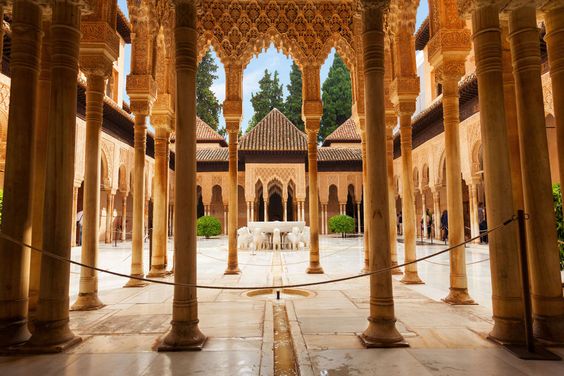
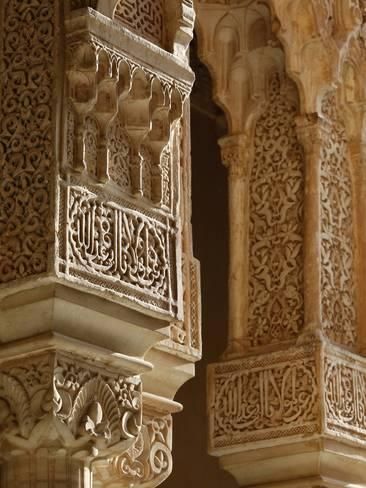
Alcazaba Stanowi najstarszą zachowaną budowlę mauretańską na terenie Grenady. W czasach panowania Nasrydów została rozbudowana.. Przez długi czas była wykorzystywana przede wszystkim do celów wojskowych, potem jako królewska rezydencja i więzienie.Alcazaba pozostaje jednym z najlepszych punktów widokowych na terenie miasta. Ze znajdującej się w jej obrębie Torre de la Vela rozciąga się wspaniały widok na Alhambrę, Grenadę i pasmo gór Sierra Nevada.
Alcazaba <It is the oldest preserved Moorish building in Granada. During the reign of Nasrid, it was extended .. For a long time it was used primarily for military purposes, then as a royal residence and prison.The Alcazaba remains one of the best viewpoints in the city. The Torre de la Vela located within it has a magnificent view of the Alhambra, Grenada and the Sierra Nevada range.>
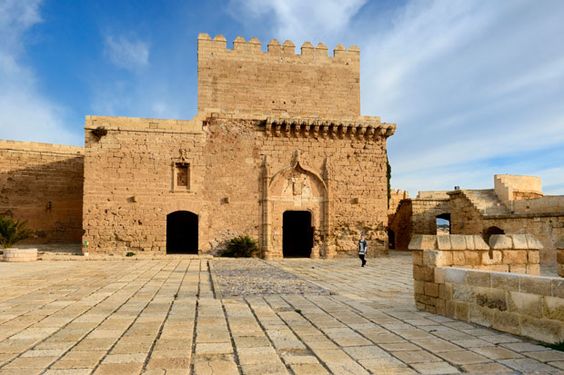
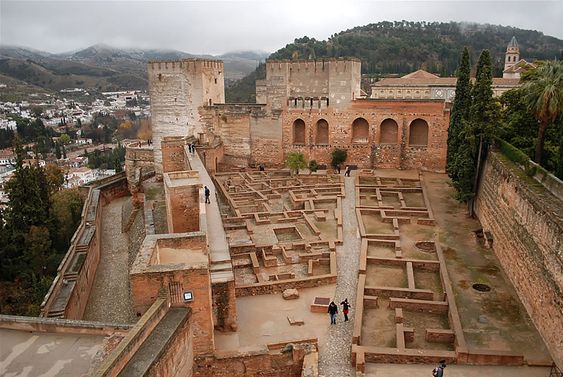
Pałac Karola V Znajduje się pomiędzy Alcazaba a pałacem Nasrydów. Powstał znacznie później bo w XVI wieku już za czasów Królów Katolickich. Miał być symbolem zwycięstwa nad dynastią arabską. Pałac zbudowany jest na planie kwadratu, w środku znajduje się patio otoczone kolumnadą w stylu jońskim i doryckim.Obecnie pałac mieści w swoich murach Muzeum Sztuk Pięknych i Muzeum Alhambra. Odbywają się tu także wystawy czasowe, koncerty w ramach projektu Granada Music oraz festiwale tańca.
Palace of Charles V <It is located between the Alcazaba and the Nasrid palace. It was established much later in the 16th century already in the times of the Catholic Kings. He was to be a symbol of victory over the Arabian dynasty. The palace is built on a square plan, in the middle there is a patio surrounded by a colonnade in Ionic and Dorian style. Currently, the palace houses within its walls the Museum of Fine Arts and the Alhambra Museum. There are also temporary exhibitions, concerts as part of the Granada Music project and dance festivals.>
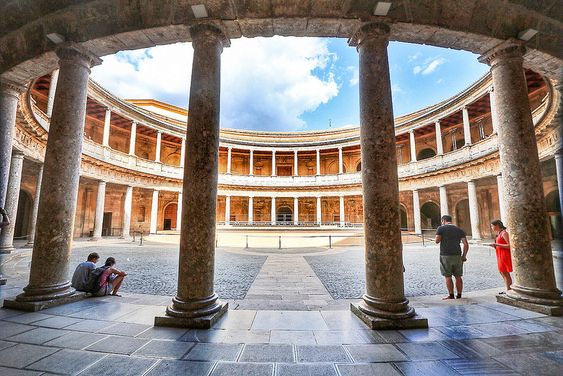
Generalife
Ogrody i pałac letni emiratów Grenady to prawdziwa rozkosz dla oczu.Generalife jest jednym z najstarszych zachowanych ogrodów mauretańskich. Kompleks pałacowo-ogrodowy powstał za panowania Muhammada III. Orientalną oazę zieleni założono wzdłuż wąskiego, długiego basenu. Otaczają go dywany kwiatowe, krzyżujące się fontanny, kolumnady.
Generalife <The gardens and the summer palace of the emirates of Granada are a real delight for the eyes. Generalife is one of the oldest preserved Moorish gardens. The palace and garden complex was created during the reign of Muhammad III. An oriental oasis of greenery was established along a narrow, long pool. It is surrounded by flower carpets, fountains crossing, colonnades.>
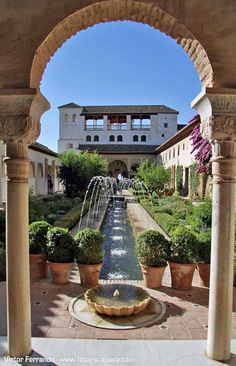
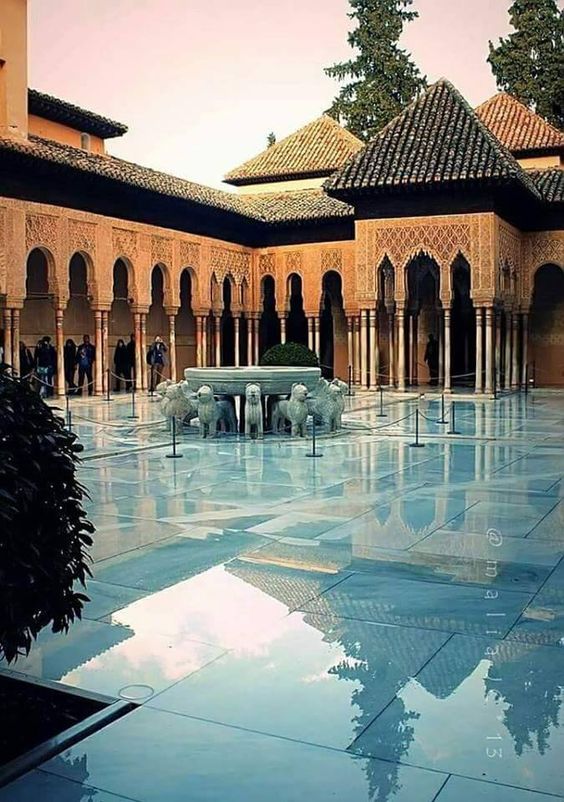
Każdy z czterech kompleksów posiada oddzielne ścieżki, rzeźby, zabytkowe fontanny, zaułki, mające swoje historie, legendy i symbolikę. Nie sposób jednak opisać każdy detal z osobna. Dlatego przy wejściu do Alhambra należy zaopatrzyć się w mapę, która pozwoli nam trafić do wszystkich najciekawszych punktów wycieczki i wskaże te warte naszej uwagi («must-sees»).
<Each of the four complexes has separate paths, sculptures, antique fountains, alleys, having their stories, legends and symbolism. However, it is impossible to describe each detail separately. Therefore, at the entrance to the Alhambra, you should obtain a map that will allow us to find all the most interesting points of the trip and indicate those worth our attention («must-sees»).>
